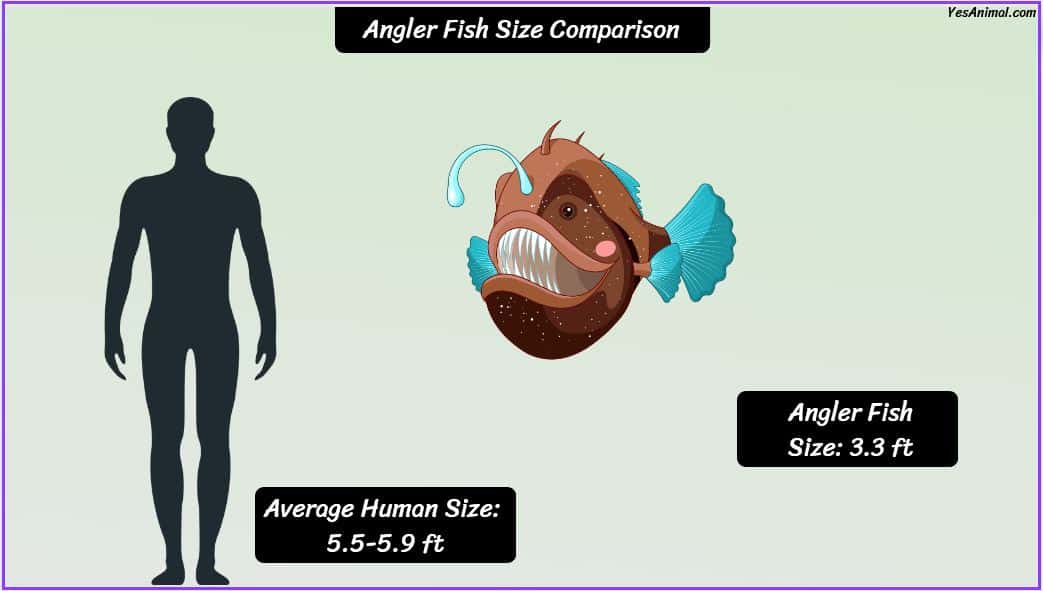Unveiling The Mysteries Of Angler Fish Size: A Comprehensive Guide
Angler fish size is one of the most fascinating aspects of marine biology. These deep-sea creatures are not only unique in appearance but also vary significantly in size depending on their species and habitat. From the smallest to the largest angler fish, this article will take you on an in-depth exploration of their dimensions, behaviors, and ecological roles.
Angler fish, known scientifically as Lophiiformes, have captivated scientists and enthusiasts alike due to their bioluminescent lures and bizarre physical characteristics. Understanding their size variations is crucial for appreciating their role in the oceanic ecosystem. This article will provide detailed insights into the size range of angler fish, their growth patterns, and factors influencing their dimensions.
Whether you're a marine biology student, an avid ocean enthusiast, or simply curious about these mysterious creatures, this article aims to deliver comprehensive and authoritative information. Let's dive into the world of angler fish and uncover the secrets behind their sizes.
Table of Contents
- Angler Fish Biology and Classification
- Different Species and Their Sizes
- Growth Patterns and Development
- Habitat and Environmental Influence
- Size Comparison Across Species
- Ecological Role and Importance
- Interesting Facts About Angler Fish Size
- Recent Research and Discoveries
- Threats to Angler Fish Populations
- Conclusion and Final Thoughts
Angler Fish Biology and Classification
Angler fish belong to the order Lophiiformes, which comprises over 300 species. These creatures are primarily found in the deep sea, where light is scarce, and survival requires unique adaptations. One of the most distinctive features of angler fish is their illicium, a modified dorsal fin ray that serves as a lure to attract prey.
Scientific classification reveals that angler fish are divided into several families, each with its own characteristics and size ranges. For instance, the family Melanocetidae includes black seadevils, which are typically smaller than those in the family Ceratiidae, known for their larger females.
Unique Physical Features
Aside from their bioluminescent lures, angler fish exhibit other remarkable physical traits:
- Large mouths with sharp teeth
- Flexible stomachs to accommodate large prey
- Sexual dimorphism, where females are significantly larger than males
Different Species and Their Sizes
Angler fish species vary greatly in size, with some as small as a few centimeters and others reaching lengths of over a meter. The species' size is often influenced by its ecological niche and evolutionary adaptations.
Small Angler Fish Species
Species like the dwarf anglerfish (Cryptopsaras couesi) are among the smallest, typically measuring less than 3 cm in length. Despite their small size, these fish play a vital role in their ecosystem by preying on tiny organisms.
Larger Angler Fish Species
On the other hand, species such as the giant anglerfish (Ceratioidei) can grow up to 1.2 meters in length. These larger species are often found in deeper waters and have more pronounced physical adaptations for hunting larger prey.
Growth Patterns and Development
The growth of angler fish is influenced by several factors, including genetics, diet, and environmental conditions. Female angler fish tend to grow much larger than males due to their reproductive roles and the energy demands of carrying developing embryos.
Factors Affecting Growth
Several key factors contribute to the growth patterns of angler fish:
- Availability of food resources
- Water temperature and pressure
- Genetic predisposition
Habitat and Environmental Influence
The habitat of angler fish plays a critical role in determining their size. Most species inhabit the abyssal plains and bathypelagic zones of the ocean, where food is scarce, and competition is intense. These conditions have led to evolutionary adaptations that maximize their survival chances.
Impact of Depth
Angler fish living at greater depths tend to grow larger due to the availability of specific prey and reduced predation pressures. Additionally, the pressure at these depths influences their physical structure, allowing them to maintain their size efficiently.
Size Comparison Across Species
Comparing the sizes of different angler fish species provides valuable insights into their ecological roles. For instance, while the giant anglerfish dominates its deep-sea environment, smaller species like the dwarf anglerfish occupy niches where their size offers advantages in avoiding predators.
Key Size Differences
Here are some notable size differences among angler fish species:
- Giant anglerfish: up to 1.2 meters
- Dwarf anglerfish: less than 3 cm
- Black seadevil: approximately 20 cm
Ecological Role and Importance
Angler fish play a crucial role in maintaining the balance of deep-sea ecosystems. Their predatory behavior helps control populations of smaller organisms, while their unique reproductive strategies ensure the continuation of their species despite harsh environmental conditions.
Impact on Marine Ecosystems
By preying on a variety of organisms, angler fish contribute to the nutrient cycling in deep-sea environments. Their presence also supports biodiversity by creating opportunities for symbiotic relationships with other marine species.
Interesting Facts About Angler Fish Size
Here are some fascinating facts about angler fish size:
- The largest recorded angler fish was over 1 meter long.
- Male angler fish are typically 10 times smaller than females.
- Some species can expand their stomachs to consume prey twice their size.
Recent Research and Discoveries
Recent studies have shed new light on the growth patterns and size variations of angler fish. Advances in underwater exploration technology have allowed scientists to observe these creatures in their natural habitats, providing valuable data on their behavior and physical characteristics.
Notable Discoveries
One groundbreaking discovery involves the identification of a new species of angler fish with unique size adaptations. This finding highlights the ongoing evolution of these creatures in response to changing environmental conditions.
Threats to Angler Fish Populations
Despite their resilience, angler fish face several threats that could impact their populations. Climate change, deep-sea mining, and overfishing are among the primary concerns affecting their habitats and survival.
Conservation Efforts
Efforts to protect angler fish populations include establishing marine protected areas and regulating deep-sea fishing activities. These measures aim to preserve the delicate balance of deep-sea ecosystems and ensure the survival of these remarkable creatures.
Conclusion and Final Thoughts
Angler fish size is a fascinating topic that reveals much about the adaptability and resilience of these deep-sea creatures. From the smallest dwarf anglerfish to the largest giant anglerfish, each species plays a vital role in its ecosystem. Understanding their growth patterns, habitat preferences, and ecological importance is essential for ensuring their continued survival.
We invite you to share your thoughts and questions in the comments section below. For more insights into marine life, explore our other articles on oceanic ecosystems and marine biology. Together, we can deepen our appreciation for the wonders of the deep sea and work towards a sustainable future for all marine life.
Data and information in this article are sourced from reputable scientific journals, including Marine Biology and Deep Sea Research, ensuring the accuracy and reliability of the content.

The actual size of a angler fish r/AbsoluteUnits

The Fascinating Differences Between Angler Fish and Humans

Anglerfish Size How Big Are They Compared To Others?